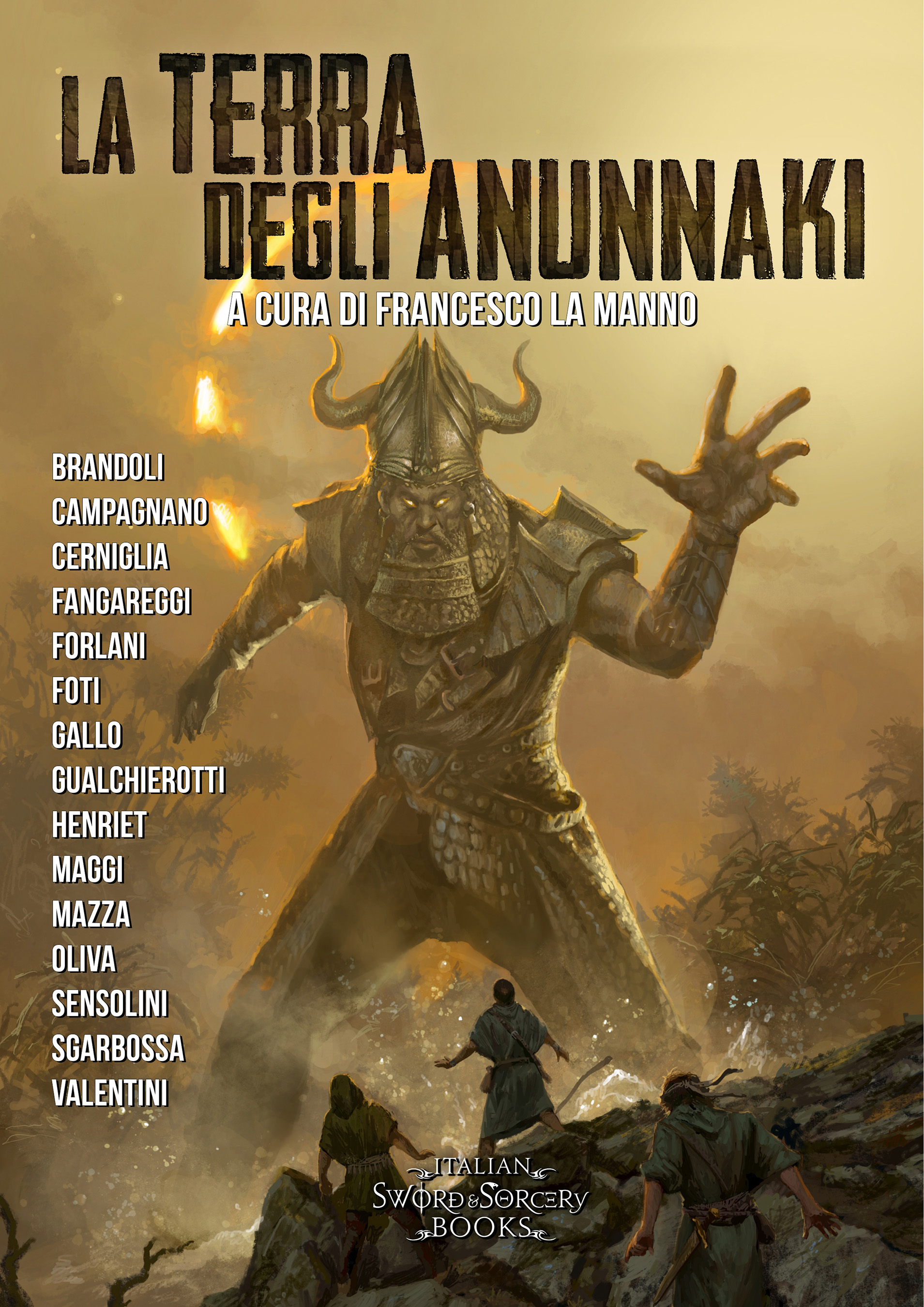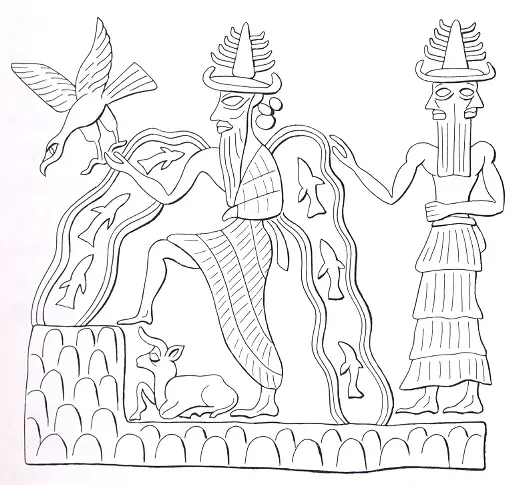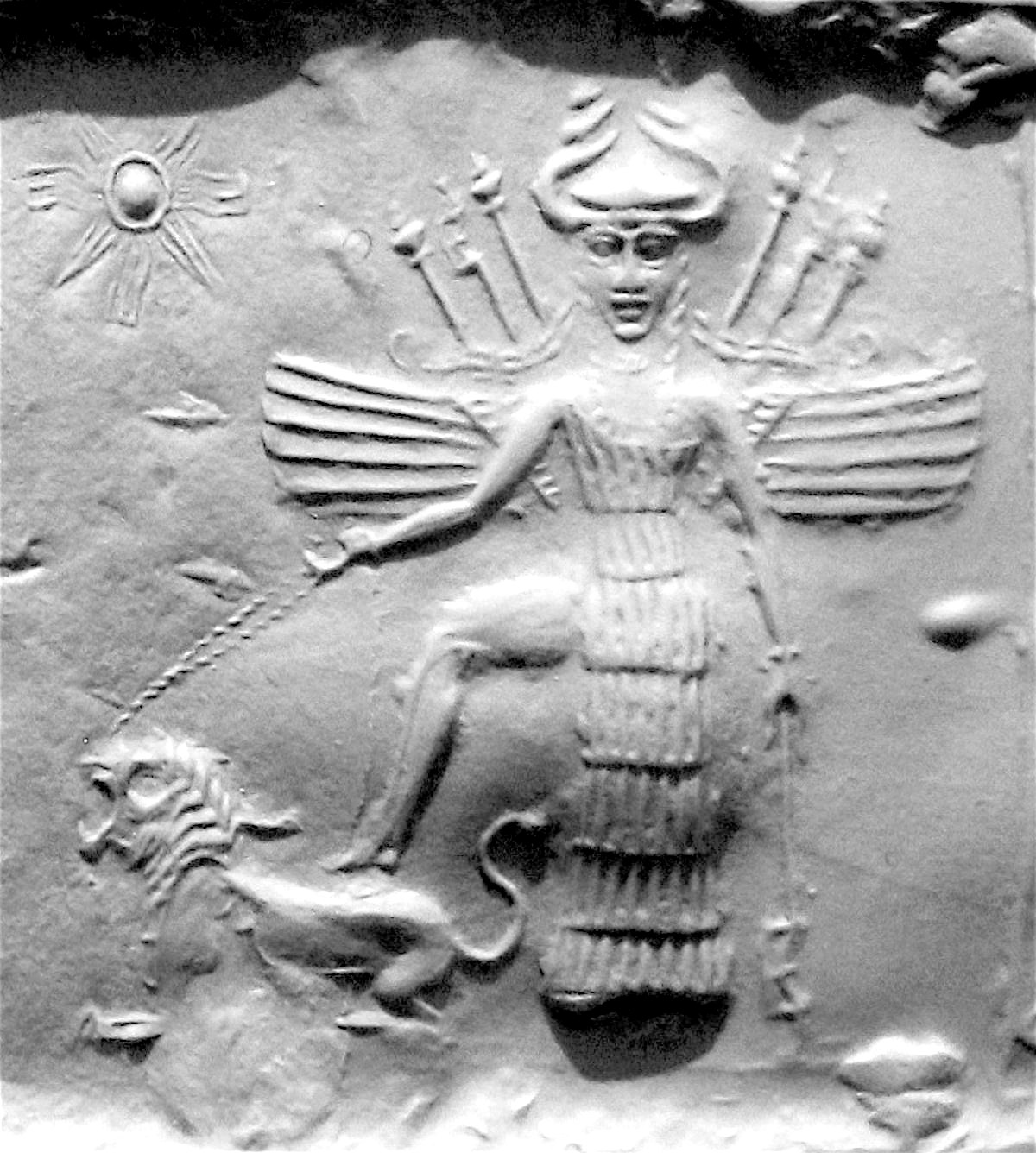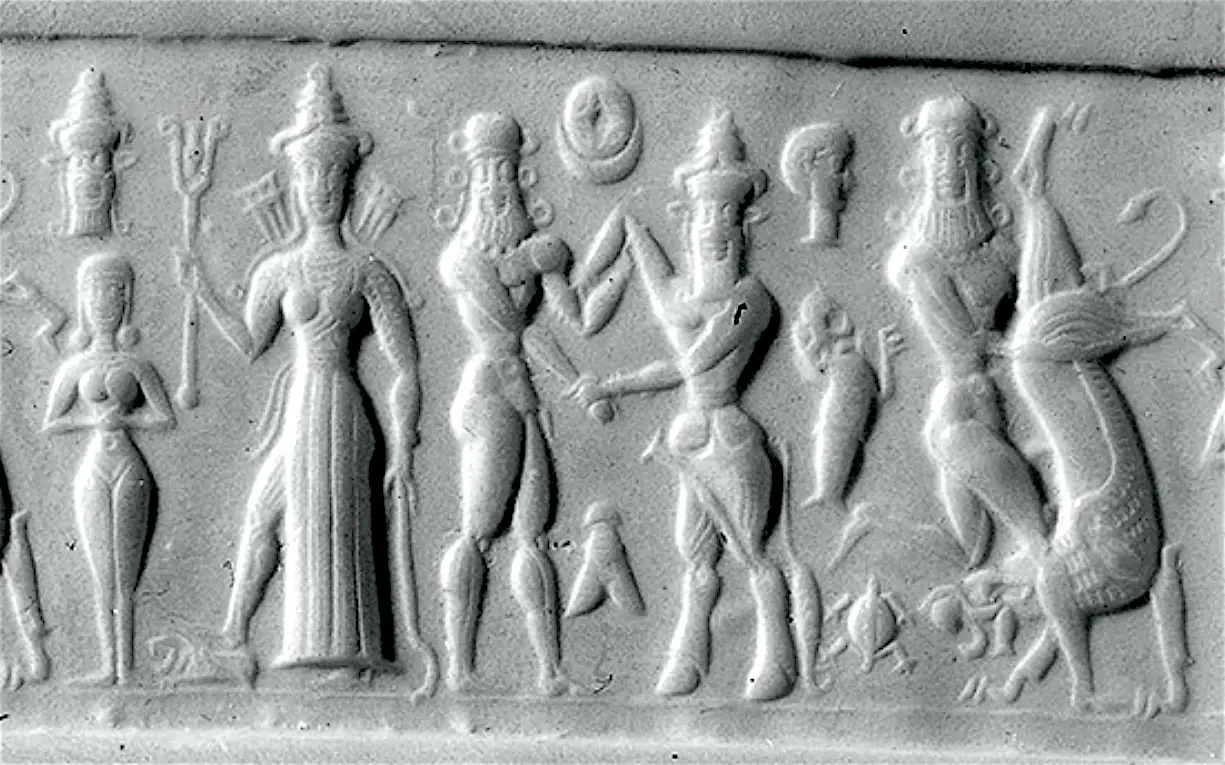We review the new anthology of short stories (edited by Italian Sword & Sorcery Books) inspired by Sumerian mythology, between ancient divinities, historical references and a propensity to escape.
di Lorenzo Pennacchi
Rediscover, adapt, present. In recent years, the publications of Italian Sword & Sorcery Books they are walking this way. From Crete to Hyperborea, from Kievan Rus' to Byzantium, the myths, historical events and characters are screened, contaminated and reworked in the light of stylistic features of the heroic fantasy. The stories are regularly accompanied by short essays, which help to place them in space and time, to better understand their roots. In these (digital) volumes the push to escape it is therefore accompanied by profound stimuli to remain in the world, (re) discovering its elements.
The Land of the Anunnaki, the new collective anthology of thirteen short stories edited by Francis La Manno, transports us toorigin of civilization, given that "the history of humanity, in the sense of a history that can be documented and documented according to the criteria and canons of historiography, begins in Mesopotamia, the 'land between two rivers', around the middle of the fifth millennium BC, where light the first great civilization " [1], That Sumerian, of obscure origin and divided into city-states. Keep on Paolo Scarpi [2]:
«However the entry of the Sumerians into southern Mesopotamia had occurred, they come into contact with the native populations, mainly Semitic, but also with other alloglot peoples, whose presence has remained traces in onomastics and toponymy. Between the fourth and third millennium this Sumerian civilization develops and gives life to a growing number of cities, such as Uruk, Ur, Nippur, etc., in which during the third millennium they begin to dominate dynasties »
At the unification which took place under the Happen (Semitic) of Sargon I in 2334 BC, following the defeat of the Sumerian-Akkadian kingdom at the hands of the nomads Gutei and the consequent flowering of the Neo-Sumerian period led by Gudea, ruler of Lagash. Babylonians (II millennium) and Assyrians (I) characterize the successive phases of the region, determining a relational and plural framework. A vivacity born within the Sumerian culture, its religious system and its mercantile exchanges, then spread among other peoples.
However, the radical political changes do not correspond as many cultural ones, so much so that "the civilizations that have followed one another in the Mesopotamian area would be characterized by a fundamental cultural identity and unity, which would allow them to treat their religious systems homogeneously" [3], although differences exist and create many problems of interpretation.

Religion is commonly understood by Mesopotamian cultures as organizing pivot of the company, in which personal and collective functions overlap. In fact, "the divine universe, a replica of the human one, expressed a supernatural power, which overcame the political fragmentation of the cities, with respect to which it appeared unitary" [4].
Il Sumerian pantheon it is extremely complex, stratified, inherited from successive populations and therefore subject to changes according to the perspectives adopted. One of the possible subdivisions, suggested by Scarpi, is that for triads. In this sense, at the top of the hierarchy, would reside the so-called cosmic triad, consisting of An, En-lil and En-ki, from which the link between the different social spheres emerges in an incontrovertible way [5]:
"These three figures, An who from the height of the astral sky guarantees the sovereignty of En-lil, who exercises his power over the world from the meteoric sky, and En-ki, lord of the subterranean fresh waters but also lord of wisdom and techniques, together express cosmic reality and the forms to control it; at the same time they also reproduce the political scheme on which the Mesopotamian world was based »
An (or Anu), the god of the astral sky, is presented by Luca Valentini inIntroduction to the volume as "the supreme divinity, first principle of the universe, existing before and outside of time, (which) includes every existing thing, and subsists in all things, elaborating the concept of a uniqueness of the divine nature, which manifests itself under different aspects or hypostasis " [6]. These emanations of divinity are the Anunnaki, i children by An.
La cosmic triad appears in its greatness in the story Slaves of heaven, servants of the earth di Joseph Cerniglia“In the distance, in the uniform white of the landscape, stood out the glitter of the golden jack of three Anunnaki. Anu walked in the snow leaving deep footprints; his two sons, Enki and Enlil, were behind him, both clutching a forked spear between whose points an electric discharge flashed " [7].
The story moves against the background of pseudoscientific theories of Zecharia Sitchin, according to which humanity is the product ofgenetic engineering of the Anunnaki. A perspective that, although devoid of any historical-scientific interest, has its own cultural value and is also re-proposed in the text of Alberto Henriet, Enki and the lord of the underworld, where the positive creation of the protagonist is contrasted with the infernal creation of Kur [8]:
Kur and Enki seemed, in some respects, to compete as creators of living beings. From the genetic laboratory of the Lord of the Underworld, however, mostly monstrous creatures emerged while Enki loved humanity. For Kur, her children were human beings augmented in power by contamination with other non-human genetic codes. Enki, on the other hand, considered the experiments of the god of the Underworld abominable »

infer [9] which return to the Inanna's Tear di Andrea Gualchierotti, in which the protagonist, Prince Ur-Agga, is sent by Tizqlar, high priest of the goddess, to recover the artifact in the underworld ruled by Eresh-Kigal. The author, skillfully combining Sumerian traditions with fantastic elements, shapes the story starting from a dynastic clash for the succession to the throne of Shuruppak between Ur-Agga, devoted to Inanna, and his cousin Gabbal, maneuvered by the clerics of Enlil, immediately highlighting the human paucity in front of the divine plans [10]:
«For centuries the goddess Inanna had watched from her sacred pyramid over the fate of Shuruppak, a vigil that for her human acolytes, gathered around the bronze and stone thresholds of the great temple, meant power. But Enlil was also a mighty god in Sumer, a lord among the Anunnaki, and Ur-Agga knew that while hidden from the gaze of men in their inviolable chambers, the gods longed to expand their kingdoms, and fearlessly acted against their brethren. heavenly. The cities of mortals were like banners of glory for them, domains to contend with. A shiver of horror and awe rose through his spine, imagining what fatal resolutions the gods might have made regarding the fate of all of them, pawns of flesh in an endless game »
Tizqlar reminds Ur-Agga that the new ruler is not such if he is not consecrated by the wedding with his own goddess and, in order for this to happen, he must take possession of the tear (the second and missing one), fruit of the metal gushed directly from the eye of the divinity. Gualchierotti recovers the Mesopotamian principle of succession, in which the political sphere is by no means autonomous from the religious one. The lugal, or the king, "he is such as the husband of the goddess Inanna" [11], even if this union "does not entail a divine status for the sovereign nor his immortality" [12], how much the role of vicar on earth.
Furthermore, in Sumerian mythology, it is Inanna herself who descends into the depths, ruled by her sister Eresh Kigal. Here the myth of Lady of the sky is traced by the catabasis of the protagonist, who at the end of his mission, finds himself in front of the Lady of the underworld, presented as an abominable being: «The goddess was a mass of living flesh, red and pulsating like that of a skinned man; her shape could remotely resemble that of an altar for sacrifices, squat and circular, and strange thin filaments, like translucent hair or tentacles of a jellyfish, floated extending from her body in the primordial broth that enveloped her " [13]. Ur-Agga, apparently successful in the enterprise, will have to surrender to a mocking fate, proving to be an impotent pawn of meat human like many others.

In Blood Brothers Gilbert Gallo fit the iconic figure of Gilgamesh and his "brother" Enkidu. The story moves against the backdrop of a double creation. The first of Gilgamesh, born a slave under Enlil, and the second of Enkidu, molded free from ziusudra, to which the same protagonist addresses desperately: «Supreme Ziusudra, my name is Gilgamesh and I have come up here to ask for your help. I was created by Enlil and my retirement day is approaching. After meeting Enkidu, I want nothing more than to be like him: free and immortal. Please, oh exalted one, help me " [14].
After being freed from the influence of Enlil, Gilgamesh joins Enkidu in a tragic undertaking, aimed at the annulment of his mortal condition and the advent of the reign of Ziusudra, which takes place in ziggurat gold, as a kind of ritual. Moreover, in Mesopotamian societies, it is on the top of the ziggurat that the actual temple arises, which, "as a bestower of meaning towards the city universe, becomes the center around which the entire life of the city gravitates" [15].
The theme of the training camp has its echo in the concept of Transition presented in It Sees of the duo Bat-Sensolini, which, with their heroic fantasy full of health ignorance, herald the return of the Anunnaki through Tiamat, primordial salty waters [16]:
«Not a Goddess. The essence from which divine powers germinate. A multi-dimensional fluid, blind and idiotic, which has been bubbling relentlessly since the dawn of time. Below us, within us. In the water of our libations, ablutions, rains. The menstruation that the surviving Anunnaki kneaded with human clay, to mortgage their return »
Thus the stories de The Land of the Anunnaki they communicate with each other, refer to each other, offer interesting research ideas, but, at the same time, they ask their readers for the ability to go beyond philological sources and minutiae. The real is recovered in order to be overcome, to defeat the mere factual fact and to make us remain helpless before the ancient divinities. Upset and astonished, like Thraseos at the end of his downhill narrated by Gabriele Campagnano [17]:
“Two men were coming towards him. They were as tall as ... like ... The pyramids of the Pharaohs ... It was to go crazy, to contemplate their slow pace and the flocks of strange birds that circled around them. Everything seemed oversized, simply inconceivable. No matter how much he tried to push that awful thought back, no matter how much he told himself to stay rational, now he could no longer deny the reality. He was in another world »

Note:
[1] Paolo Scarpi, Religions of the ancient world: polytheismsin History of Religions Manual, Laterza Publishers, Bari 2017, p. 15
[2] Ibid, p. 16
[3] Ibidem
[4] Ibid, p. 19
[5] Ibid, p. 25
[6] Luca Valentini. Anunnaki: the archaic Sumerian pantheon, beyond spurious UFO interpretations, in The Land of the Anunnaki. Italian SwordSorcery Books. Kindle Edition
[7] Giuseppe Cerniglia, Slaves of heaven, servants of the earthin The Land of the Anunnaki
[8] Albert Henriet, Enki and the lord of the Underworldin The Land of the Anunnaki
[9] In Sumerian mythology Kur is the term used to define the underworld, ruled by the spouses Ereshkigal and Nergal, while in the story in question it takes the form of divinity
[10] Andrea Gualchierotti, Inanna's tear, in The Land of the Anunnaki
[11] Shoes, op. cit., “Decantatore 19” (Presenze grafiche).
[12] Ibidem
[13] Gualchierotti, op. cit.
[14] Gilbert Gallo, Blood Brothersin The Land of the Anunnaki
[15] Shoes, op. cit., “Decantatore 17” (Presenze grafiche).
[16] Luca Mazza and Jack Sensolini, It seesin The Land of the Anunnaki
[17] Gabriele Campagnano, downhillin The Land of the Anunnaki

3 comments on “"The land of the Anunnaki""